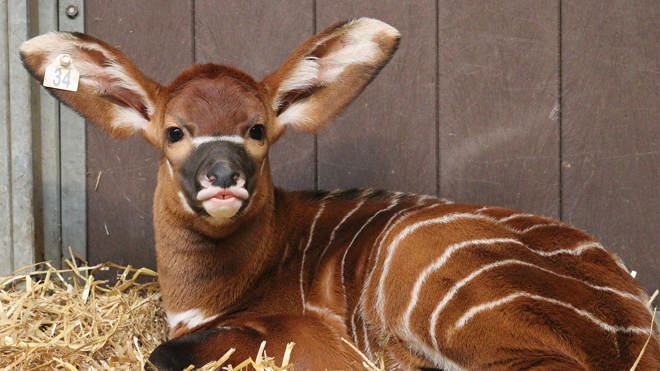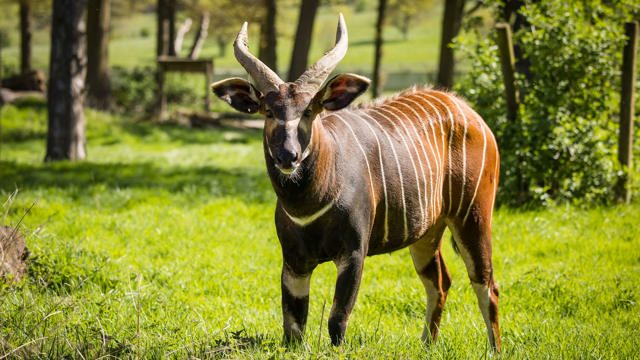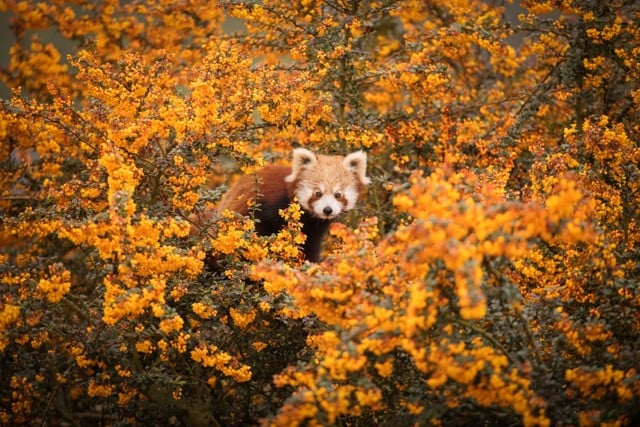
Overview
At Woburn Safari Park there is a breeding herd of Eastern mountain bongo that can be seen on the Road Safari in the enclosure they share with the Barbary macaque monkeys.
This large species of African forest antelope is listed as critically endangered due to poaching and illegal trapping.

All about us
| Distribution: | Confined to isolated populations of forest on Mt. Kenya, the Mau and Eburu forests and the Aberdares. |
|---|---|
| Habitat: | Dense tropical forest, high montane and bamboo forests. |
| Height: | 110 to 130 cm at the shoulder |
| Weight: | 240 to 400 kg |
| Lifespan: | 19 years |
| Threats: | Poaching and illegal trapping. |
About Us
Scientific name: T. eurycerus isaaci
Eastern mountain bongo typically live in small family groups of up to eight females and their young. They have a flexible social structure and appear to have no lasting bonds.
Both the male and female Eastern mountain bongos have horns that spiral into one complete twist, but the males typically have much darker coats.

Bongo typically live in small family groups of up to eight females and their young however, large nursery groups often aggregate after the calving period. Soon before young males reach sexual maturity they are pushed out of the herd by the dominant male and will usually live a solitary life occasionally pairing off with another adult male or female. Bongo have a flexible social structure and appear to have no long lasting bonds.
Females may initially behave aggressively and defensively to a bull’s approach which is usually followed by flight. A bull will continue to follow a cow in oestrous until her escape tactics diminish which is when the mating march will begin. A bull may begin by maintaining a low stretch stiff posture whilst using vocal communication by clicking his tongue. Cows will usually urinate in front of a bull so he can test the urine to see how receptive she is. If she is in oestrous the male will continue to pursue her and lick and rub against her before resting his head on her rump and mounting her. Following copulation it is common for both the bull and the cow to rub their heads on each other’s sides.
After a nine month gestation a single calf is born. During the first few weeks of the calf’s life they will lay hidden in the forest where it will remain until its mother comes to feed it every few hours to avoid detection by predators. Once the calf is a few weeks old they will re-join the herd and if there are other mothers with offspring they can form a nursery herd. The calves are weaned at six months of age and fully independent at one year of age.
Bongo are browsers and they live in areas with abundant year round growth of herbs, low shrubs and tender bushes that grow at the base of trees. Leaf tips, shoots, roots and the vines of a wide variety of other plants including bamboo, cassava and sweet potato are also eaten. They use their long prehensile tongue to grasp and feed on vegetation and they can also uproot saplings with their horns to get at the roots. Bongo are also able to reach browse 7 to 8 feet off the ground by rearing up on their hind legs and bracing their forelegs against a tree trunk and using their broad horns for pulling and breaking high branches.
Bongo have short hair with a long tufted mane from their shoulders to their rump. Females primarily have a bright chestnut coat whilst males become much darker as they age and their coat will almost become mahogany in colour. They have between 10 to 16 vertical narrow stripes on the sides of their body, a black belly and a pure white chevron that crosses the bridge of their nose as well as additional smaller white patches on the side of the head.
The Bongo is the only tragelaphid in which both sexes have horns that spiral into one complete twist. The core of a bongo's horn is hollow and the outer layer of the horn is made of keratin. Bongo are notoriously shy animals that will flee deep into the surrounding forest if startled. As they run at full speed they will lay their spiralled horns on their backs so that the thick bush cannot impede its flight. Their massive build and short legs are an adaptation to movement through dense vegetation and they have particularly large ears which improve its sense of hearing amongst the dense thickets and forest in which it inhabits.
Bongo are susceptible to disease such as rinderpest which in the 1890s almost exterminated the species and the young are very vulnerable to predation by lions, pythons, leopards and hyenas. Dense human populations are also a big threat to the species as vast numbers of humans live near to all the known East African bongo refuges. However, the biggest threat of all is the large scale poaching and illegal trapping for food and skins that have resulted in the decline of bongo populations and even their complete elimination in some areas. Unrestricted hunting with dogs and snares has had a particularly strong impact on the Eastern Bongo and charities such as the KWS (Kenya Wildlife Service), the RSCF (Rare Species Conservatory Foundation) and the BSP (Bongo Surveillance Project) are carrying out community and field based conservation to try and prevent the extinction of this stunning antelope. It is estimated that there are less than 100 individuals currently in the wild and this species could be extinct in less than 20 years.
To find out more information about Bongo conservation please click on the links below.
Bongo are classified into two subspecies, the near threatened Western Lowland Bongo (Tragelaphus eurycerus eurycerus) and the critically endangered Eastern Mountain Bongo (T. eurycerus isaaci).
Although Bongo naturally will walk under rather than over obstacles captive Bongo have been observed jumping heights of over 1 ½ m!
Bongo are the largest species of African forest antelope.
Young calves have gotten so good at hiding when out in the African Jungle that it has taken the keepers a while to find them! Most were just hiding in the tall grass but some were found hiding in hollow tree trunks!
Some native people used to believe that eating or even touching a Bongo would give them spasms similar to those of epileptic seizures. This taboo once protected them but it is no longer widely believed and they are heavily poached by humans and dogs with the use of snares.
Bongo have been known to eat dirt as well as pieces of burned wood from lightning-killed trees to obtain salt!

